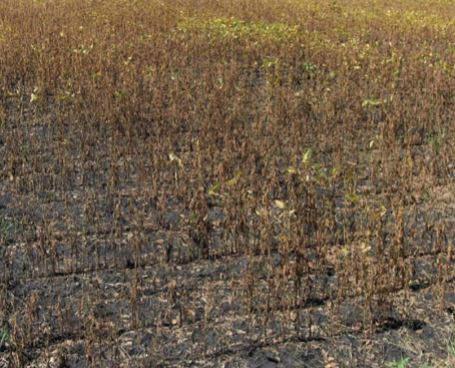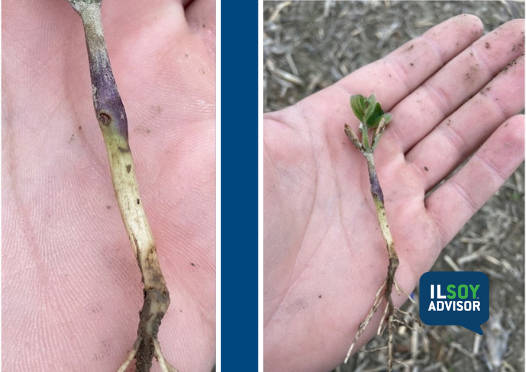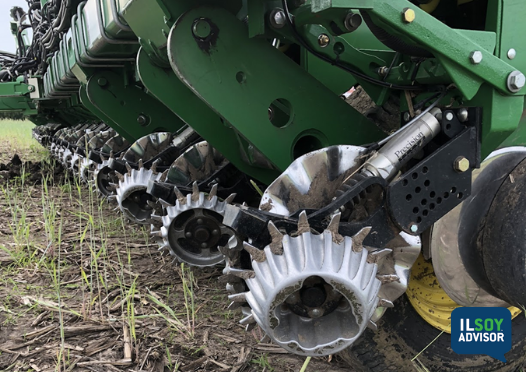ILSOYADVISOR POST
5 Reasons to Stop Your Higher Soybean Population
In the past, a higher soybean population was planted because growers used a drill and wanted a faster canopy to intercept light to reduce weed competition. With the greater use of residual herbicides (don’t skip the pre-herbicide), increased populations to aid in weed control aren’t as important anymore. In a recent webinar, Early Season Weed Control for Improved Weed Resistance Management, Dr. Bryan Young with Purdue University shared that the faster closure of canopy for weed control was achieved by reduced row spacing and not by (increased) seed population.
With higher seeding rates, soybeans can increase in height and produce pods higher off the ground, which reduces harvest loss from lower branch breakage. However, disadvantages of higher planting populations are much more numerous and can include lodging, plant competition and increased disease pressure, as well as an overall decrease of branches, pods, seeds and, sometimes, yield per acre.
Lodging: There are many factors that increase the likelihood of soybean lodging including genetics, higher fertility/productivity environments and early planting. However, higher plant populations are another factor that can cause soybean lodging. If lodging occurs at the beginning of seed-fill, yields can suffer. For example, if you attempt to “fill in” areas to increase stand, you could also be increasing chances of lodging and other disadvantages if final stands become too thick.
Plant Competition: An increase in plant population per acre can cause competition for water and nutrients, and increase stress. With fewer plants, each plant can increase leaf area, capture more sunlight and allow for more branching and pods, all things that boost yields. With optimum plant density, the appropriate number of pods and seeds can occur, dependent on variety and environment. Weeds can also compete with the soybean crop, lengthening time between vegetative stages or shortening time between reproductive stages.
Disease: For a disease to occur you need a pathogen, a susceptible host and a favorable environment. Soybean varieties differ in disease susceptibility. However, increased population could create a more favorable environment for some diseases. An excessive number of plants can cause more humidity within the canopy, creating a favorable environment for white mold and leaf diseases. Increased plant competition and stress can lead to a higher susceptibility to a disease like charcoal rot. Another example of a disease that could thrive at greater populations is stem canker.
Severe charcoal rot in a field caused by soilborne fungus Macrophomina phaseolina. (Photo from Crop Protection Network Charcoal Rot publication CPN-1004).
Early Planting: Early planting (mid-April until May 1st) at 120,000 to 130,000 plants per acre, with a uniform final stand of around 100,000 plants per acre, lays the foundation for greater yields. If you are concerned this year with issues such as germination, soil type or poor seedbed conditions, you may feel more comfortable bumping up your population. According to Early-Season Soybean Management, a rule of thumb is to expect 80% of plants to emerge when planting quality seed within good soil conditions. With early planting, our goal is to achieve efficient interception of the maximum amount of light early when it is needed at the R2 growth stage for more nodes and pods. There are more days to grow before the longest days of the year, which increases light interception and can lead to higher yields. Be aware that yields are not increased only by lowering populations, but this is one factor in growing soybeans with a systems approach, which has many complex interactions consisting of soil conditions, variety selection, weather and management.
Optimize Your Return with Seed Treatments: Most importantly, by investing in high-quality seed with treatments, research has shown planting populations can be reduced. This protects your seed investment when planting early. Reducing seeding rate can be a very important management decision when factoring in seed cost. A full seed treatment results in greater emergence and vigor, as well as a more uniform stand. Ultimately, an optimal plant population for soybean production can increase both yield and profitability.
Lastly, the next question that crop consultants and agronomists are asking: Can Better Seed Singulation Improve Soybean Yield? Many agronomists think that by improving soybean planting depth as well as the plant-to-plant spacing, one could improve pod count and yield potential, but more research needs to be done to answer this question





Comments
Add new comment